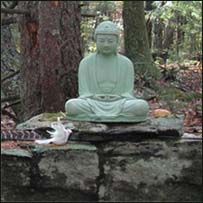|
|
 |
Please support Dharma Seed with a 2025 year-end gift.
Your donations allow us to offer these teachings online to all.

|

|

|
The greatest gift is the
gift of the teachings
|
|

|
| |
|
Dharma Talks
|
2022-09-28
The Liberating Power of Conscious Intention – Part 1
54:25
|
|
Tara Brach
|
|
|
While we can’t change our past, we have the capacity in this moment to remember our deepest intention and seed the future. Intention can become the compass of our heart, guiding and creating our life experience.
In these two talks we explore how we awaken mindfulness of intention and how, when we are caught in habits that create suffering, we can find our way home to the deep intention that heals and frees us. The two talks include reflections and practices that can bring the power of intention alive in your life.
|
|
Insight Meditation Community of Washington DC
|
|
|
2022-09-23
Meditation on presence of mind, Dhamma talk Part 1 on Satipaṭṭhāna: The Body
1:37:55
|
|
Bhante Sujato
|
|
|
Meditation on presence of mind. Beginning of dhamma talks on Satipaṭṭhāna. Part 1: The Body. The meanings of Satipaṭṭhāna; explicitly means meditation. The four Satipaṭṭhāna meditations are body (kāyānupassī), feelings (vedanānupassī), mind (cittānupassī), principles (dhammānupassī). The body as something simple to ground oneself on. Mindfulness as "presence of mind", related to time, to keep on remembering and being conscious with firmness and steadiness.
|
|
Lokanta Vihara
|
|
|
2022-09-22
The Judging mind
59:57
|
|
Sally Armstrong
|
|
|
Many of us have a tendency to be critical and judgmental of ourselves and others. In meditation, this habit can seem quite strong and can create a lot of suffering. But mindfulness is a wonderful tool to enable us to see these thoughts for what they are, so we can begin to bring wisdom and understanding to them. The good news is, like any conditioned habit, we can learn to decondition this pattern.
|
|
Insight Meditation Society - Retreat Center
:
Three-Month Retreat - Part 1
|
|
|
2022-09-21
Radical Acceptance – Our Gateway to Love and Freedom
39:38
|
|
Tara Brach
|
|
|
Our capacity to realize the truth of who we are and to love fully, arises from moments of true acceptance. This means meeting our unfolding life with an unconditional, open and tender presence. This talk on Radical Acceptance explores how the trance of unworthiness contracts us away from presence, and how activating mindfulness and self-compassion with RAIN loosens the grip of self-aversion and awakens our hearts.
|
|
Insight Meditation Community of Washington DC
|
|
|
2022-09-16
Chanting, Guided meditation on the breath, Q&A
1:10:21
|
|
Bhante Sujato
|
|
|
Chanting. Guided meditation on the breath as a simple kind of abiding; Audience Q&A: Q: How to overcome the body restricting the breath? ~A: 1. Patience. 2. Slight shift to focus on the out-breath 4. Contemplate non-self 5. Focus on pleasure in the breath. Q: How to let go of worry? ~A: Uddhacca-kukkucha one place to look, 'like conditions like' so to be happy tomorrow, do something good now. Q: Is mindfulness different to concentration? ~A: 'Concentration' term can convey controlling solutionism but concentration fine as a word. Q: Technique of being without your breath for 20 minutes by telling the breaths you love them? Q: What did the Buddha say about monarchism? Q: Meditation during lucid dreaming?
|
|
Lokanta Vihara
|
|
|
2022-09-14
Navigating Conflict with a Wise Heart – Part 2
57:05
|
|
Tara Brach
|
|
|
This series of talks offers guidance in transforming conflict into a portal for awakening your understanding, flexibility and compassion. We look at how to heal our own unmet needs and not be dependent on others changing; and how to engage with another person when both are dedicated to mindful communication. We also extend our exploration to societal conflict. The talks are accompanied by reflections and meditations that can directly enhance your capacity to respond to conflict from the most wise and caring part of your being.
|
|
Insight Meditation Community of Washington DC
|
|
|
2022-09-07
Navigating Conflict with a Wise Heart – Part 1
54:33
|
|
Tara Brach
|
|
|
This series of talks offers guidance in transforming conflict into a portal for awakening your understanding, flexibility and compassion. We look at how to heal our own unmet needs and not be dependent on others changing; and how to engage with another person when both are dedicated to mindful communication. We also extend our exploration to societal conflict. The talks are accompanied by reflections and meditations that can directly enhance your capacity to respond to conflict from the most wise and caring part of your being.
|
|
Insight Meditation Community of Washington DC
|
|
|
2022-08-31
Guided Meditation Exploring Reactivity and Feeling-Tone
35:00
|
|
Donald Rothberg
|
|
|
After brief basic meditation instructions related to stabilizing attention with an anchor, and then being present to the anchor or whatever else is predominant, there is an 8-minute or so period of settling and stabilizing. Then there is guidance to notice and be mindful of any kinds of reactivity (manifesting in the body, emotions, and thoughts), if in the workable range. After another 10 minutes or, there is guidance to notice a moderate or greater level of the pleasant or unpleasant (as long as it is workable), staying with the sense of pleasant or unpleasant, noticing any tendencies to reactivity (wanting and grasping, or not wanting and pushing away, at the levels of body, emotions, and/or thoughts).
|
|
Spirit Rock Meditation Center
:
Monday and Wednesday Talks
|
|
|
|
|